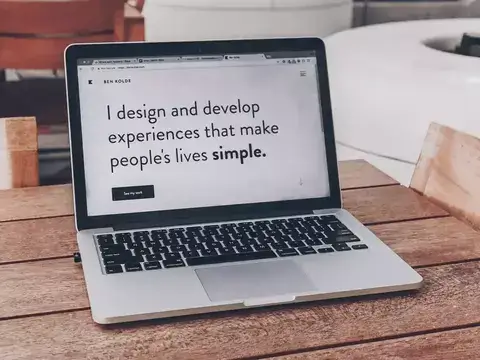Best Practices for SMB Website Copywriting
5 MIN READ

15 seconds. That's how long you have to impress a potential customer. More than half of visitors will click away from your website in that small time frame. What's one of the things that make people "bounce" so quickly? Really bad copy. Does this sound like your small business? Not to worry. There are many ways to improve your website copy and make your offers appealing and damn near impossible to resist.
Let's take a look at how Wedbuddy was able to increase free trial signups to their wedding website builder. The original copy on their landing page read "no credit card required" and a "free trial. They changed it to "Create a beautiful personalized wedding website in minutes." This highlights the benefits of using their website builder instead of payment details. They also removed a long list of features. The result? Wedbuddy saw 139% more clicks to signup and 73% more free trial signups.
Did you know words had that much power?
BEST PRACTICES FOR SMB WEBSITE COPYWRITING IN 2019
Below are some best practices to follow when writing copy for your homepage and product/service page(s):
HOMEPAGE COPYWRITING
So you're getting traffic to your homepage, but your bounce rate is sky high. What's the problem? What can you do to improve the copy on your homepage?
1. MAKE IMPORTANT POINTS STAND OUT ON THE PAGE
The average person will only read 20% of the content on a web page. That means you should always make sure important points stand out on the page by using header tags, bullet points, bold, and italics. Make things like your unique selling points (USP), product benefits/features, and promotions stand out in the copy. For example, maybe you're selling an SEO service and what makes your product stand out from competitors is full integration with marketing automation software. That's the information you want to make obvious to your audience.
Not highlighting important points can backfire big time. You could have some golden nuggets in there, and no one would even know. They'd just click off the page and move on.
2. AVOID SPELLING AND GRAMMAR MISTAKES
If you want your potential clients to trust you, whatever you do, don't make mistakes in your copy. Nearly 60% of visitors avoid doing business with a company that made obvious spelling and grammar mistakes. Why? Because not only do errors make your copy look unprofessional, they also make it look like they just don't give a shit.
Proofread your copy to ensure that it's free of mistakes. You can also get someone to look over it for you to catch mistakes you may have missed. If you need additional help with proofreading, you can use free tools like Hemingway Editor and Grammarly.
3. BE FUN AND EXCITING
No one wants to read a bland copy. It's bad enough attention spans are getting shorter these days. So try to grab your audience's attention in a creative way. Say something bold. Be different from your competitors. Don't be afraid to go against the grain.
For example, one company did an A/B test - more on that here - to see the impact of changing a few words in their email subject line. The original version read, "How to Find Long-Tail Keywords on the Fly." The variation to that was "Hell Yeah – How to Find Long-Tail Keywords on the Fly." The second variation was the winner. It had led to a 23.88% higher email open rate.
Although this example deals with email headlines, the same concept can be used for writing a headline copy on your homepage. On average, 80% of people read headline copy; only 20% of them will read the rest. The better the headline, the better the likelihood of website visitors reading the rest of your copy.
Boring Words vs. Exciting Words
- New vs. Latest
- Best vs. Top-notch
- Important vs. Crucial
- Good vs. Superb
- Only vs. Exclusively
- Big vs. Massive
- Smart vs. Brilliant
PRODUCT PAGE COPYWRITING
So you've got people to your product page. But is the copy good?
1. SWAP OUT FEATURES FOR BENEFITS
Features are great and all, but they don't really resonate with potential customers as benefits do. People want to know what's in it for them before they purchase a product or service, not necessarily what a product or service can do. For example, let's say you're a SaaS company that helps clinic managers schedule and manage appointments more efficiently.
One of the software's features is it generates unique appointment notifications via email. So when you go to list that feature, along with others, on your product page, you notice that you're not getting many conversions. Why? Because you're not telling your potential clients why sending out appointment notifications will help them and their clinic. If you tweak the copy and say, "Boost attendance by reducing cancellations and no-shows with appointment reminders," prospects will be more interested in what you have to say.
2. CREATE A SENSE OF URGENCY
Four words: fear of missing out. People hate to miss out on something they want. And when they want something, boy do they want it fast. That's where urgency comes in. Add a countdown timer into your copy to let website visitors know that your offer will only last for a limited time. People naturally perceive items as more valuable when they're scarce.
You can also include urgency words such as "now," "today," "fast," "hurry," and "close" into your copy to push customers to action.
3. USE SOCIAL PROOF
Everyone likes a little social proof now and then. Here are some stats to prove it:
- 88% of consumers trust user reviews as much as personal recommendations.
- The average consumer reads 10 online reviews before making a purchase decision.
- 57% of consumers will only buy or use a business service if it has at least a 4-star rating.
One website added the phrase join "4,500 current subscribers" to their email sign up form and saw sign-ups increase by 20%.
Below are some examples of social proof you can use to make your website copy stronger:
- Starred ratings
- Reviews
- Testimonials
- Client logos
- Case studies
- Certification badges
- Press/publicity
Stick some social proof on your product pages and watch how fast you'll start to build trust with your prospects.
4. EVOKE AN EMOTIONAL REACTION
Just because you may be in the B2B space, doesn't mean emotions aren't involved in the buying process. Research shows that emotions are the main factor for making any decision - including buying decisions. Talk about the common pain points your potential clients experience on a day-to-day basis.
Are they having trouble recruiting talent? Do they struggle with bringing in clients? Highlight some of the frustrations your target audience has been experiencing with their business. This will help you connect with them on an emotional level because, through your copy, you show them that you understand their struggles, which, in turn, builds trust.
Working knowledge of website copy is so important to driving conversions on your website. But if it seems overwhelming or you need help, you can always work with an awesome agency like MarComm!
Recent Posts

The Ultimate Guide to Nav Bar Design
A man walks into Navigation Bar to have a drink and get directions to a hotel....

What Makes a Good Landing Page in 2019?
Your product landing page is like a late-night TV infomercial. It features all...

Is It Time to Outsource Your Website Design?
A few years ago, when HubSpot surprised the design world with its "17 Things...
